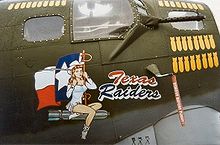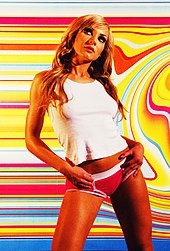Pin up

A pin-up is an image that usually shows a woman in an erotic pose and is pinned to a wall.
meaning
Translating the English term to pin up brings you closer to the essence of pin-up pictures. Because the typical thing about pin-ups is that they are often pinned to the wall. Frequent forms are calendar pictures and "center folds" (= double-sided or even larger fold-out, removable posters in / out of the middle of magazines or journals).
history

Pin-up art, which only received definition as an art form in the 1980s, was viewed as an illustration until then . So were dime novels , magazines and magazine covers - even the covers of reputable magazines such as the " Times " - illustrated with pin-ups. The graphics created by Raphael Kirchner in the 1910s, some of which were sold in large numbers as postcards, can be regarded as early forms. The pin-ups can be described as everyday art, because they were received in millions of numbers from the 1920s to the 1970s by a broad section of the population through the media mentioned above, but also through advertising posters or depicted on other objects . Pin-ups were therefore also suitable as a mass-effective medium for war propaganda, "which clearly uses erotically charged images" to stimulate one's own camp.
During the Second World War, US soldiers carried pin-up pictures millions of times with them. In 1943, 20th Century Fox photographer Frank Powolny photographed Betty Grable as a pin-up girl in a bathing suit from behind, smiling mischievously over her shoulder at the viewer. The photo was the most popular pin-up of American soldiers in World War II and was omnipresent in their lockers. It is considered iconographic for this time. 20th Century-Fox used this fame in 1944 for the film Pin up Girl .
Nose art

In the Second World War and also in the Korean War , the pin-up art gained a completely new distribution in the area of " nose art ", that is, in the painting of fighter aircraft, especially in the USAAF . In addition to comic characters and martial allegories , pictures of pin-up girls were particularly widespread, the machines were often named after the pin-up girls or the motifs were designed in such a way that they embodied the fictional character of the machine that you were the crew members assigned. In many cases, prints by pin-up girls were used as a template, but there were also numerous individual motifs created by artistically talented crew members or mechanics. Many pilots and crew members transferred these images to the back of their flight jackets in order to make it clear that they belonged to a particular aircraft.
The most famous machine with such a pin-up identity was the Memphis Belle , a Boeing B-17 bomber of the US 8th Air Fleet , which bombed a total of 25 targets in Germany and occupied France in 1942 and 1943.
Nose art is still common today, especially on units in combat, but classic pin-up girls have largely disappeared.
shape
The pictures mostly show pretty young women in various poses. Most of the time these pictures have narrative, sentimental, romantic or patriotic aspects. They show scenes from the girls' everyday life, in which small mishaps sometimes happen to them. The scenes are often erotic in nature, but suggestive rather than revealing. Even if glimpses are apparently granted (e.g. under a skirt lifted up by the wind), these are left to the viewer's imagination and do not really depict anything clearly. Usually the pin-up girls are lightly dressed, but in exceptional cases completely or partially naked girls are shown.
The whole area of pin-up art is shaped by the fact that the pictures are almost always commissioned work. B. for large calendar publishers like Brown & Bigelow . The employed artists painted the pictures according to the specifications and wishes of their clients and were therefore less free to design the pin-ups. The relative harmlessness of the images from a sexual point of view results primarily on the one hand from the respective contemporary censorship rules, on the other hand from the ideas of the publishers who wanted to make their products as popular as possible in order to be able to market them well and profitably. The artists often painted the pin-ups as reproductions in oil on canvas or cardboard , some also used pastel or gouache . Most of the naturalistically designed pin-up girls were painted in certain formats ( Gil Elvgren painted all works for Brown and Bigelow in the dimensions 76 cm × 61 cm) because they should be uniform for reprint. Often individual motifs were also repainted several times, in a different form or by another artist, or used again in a different context, because the property rights of the pictures were usually held by the contractors who did not consider them to be art and who used the existing motifs sparingly circumvented.
Others
Perhaps the best-known pin-up girl was Bettie Page , who worked in the mid-1950s but whose fame has continued into the present, as shown in the biopic The Notorious Bettie Page . The fame of the illustrator Eric Stanton and the photographer Irving Klaw date back to the time they worked with Bettie Page.
Categories

The illustrations with the motif of beautiful women can be divided into three categories, the boundaries of which partly merge into one another.
Pin up
A pin-up is a full-length picture with a narrative element. The woman in the picture is either wearing a figure-hugging item of clothing that she can wear outside the home (e.g. swimsuit, sports dress or a tight dress) or something provocative and intimate like a negligee or lingerie . Naked pin-ups, however, as already mentioned, are the exception.
Glamor girl
The next category, the glamor girl, is either a full or half-length portrait. The woman portrayed usually wears an evening dress or a costume that is less revealing than the dress of the pin-up.
Pretty girl
The third category is that of pretty girls. They were drawn by illustrators who worked for "serious" magazines. The women in the pictures were painted in a glamor style. The terms “pin-up art” and “glamor art” refer to artists who specialized in this field. “Pretty art” is almost always understood to mean motifs by artists who normally concentrated on other genres.
Pin-up calendar
For the Brown & Bigelow calendar, Gil Elvgren painted his pin-ups in 1952 based on nude studies that he had photographed himself. The Pirelli calendar appeared for the first time in 1964 and cannot be purchased. There are now countless imitators.
Well-known pin-up artists (selection)
Artists
- Joyce Ballantyne (1918-2006)
- Olivia de Berardinis (* 1948)
- Roy Best
- Al Buell (1910-1996)
- Forest Clough (1910-1985)
- Howard Connolly (1903-1990)
- Edward D'ancona
- Harry Ekman (1923-1999)
- Freeman Elliot (born 1922)
- Gil Elvgren (1914-1980)
- Harrison Fisher (1875-1934)
- Pearl frush
- Charles Dana Gibson (1867-1944)
- Patrick Hitte
- Romain Hugault (* 1979)
- Joseph Christian Leyendecker (1874–1951)
- Mike Ludlow (born 1921)
- Zoe Mozert (1907-1993)
- Knut O. Munson (1900-1967)
- Marco Nietlisbach (* 1983)
- Mayo Olmstead (born 1925)
- Walt Otto (1895–1963)
- George Petty (1894–1975)
- Mel Ramos (1935-2018)
- Bill Randall (born 1911)
- Arthur Sarnoff (1912-2000)
- Haddon Sundblum (1899–1976)
- Alberto Vargas (1896–1982)
Models
- Jeanne Carmen (1930-2007)
- Gladys Cooper (1888-1971)
- Betty Grable (1916-1973)
- Marilyn Monroe (1926-1962)
- Bettie Page (1923-2008)
- Zoe Scarlett (* 1984)
- Dita Von Teese (* 1972)
literature
- Dian Hanson: The Art of Pin-up. Taschen Verlag, 2014, ISBN 3-8365-3570-X .
- Charles G. Martignette, Louis K. Meisel : The Great American Pin-Up. Taschen, Cologne et al. 1996, ISBN 3-8228-8497-9 .
- David Perry: Hot Rod Pin-ups. Heel Verlag, Königswinter 2006, ISBN 3-89880-543-3 .
- Dietmar Schofer, Markus Schofer: Advertise pin-ups. Scheufele, Stuttgart 2004, ISBN 3-923107-22-6 .
Web links
- pinup-art.de On the history of pin-up art with a large collection of works
- mutoworld.com history and details
- Nose Art - pin ups on airplanes (one day - contemporary stories on spiegel-online)
Individual evidence
- ↑ Johannes Willms: Love, Sex and War - Pin-up Wonder Weapon. In: Süddeutsche.de. November 14, 2007, accessed August 1, 2012 .
- ↑ Betty Grable Biography. Retrieved August 1, 2012 .
- ↑ FRANK POWOLNY. In: NYTimes.com. The New York Times Company, November 1, 1986, accessed August 1, 2012 .
- ↑ Dian Hanson: The Strange Pin-Up Prince. In: Taschen-Katalog Winter 2014, p. 54 ff.


